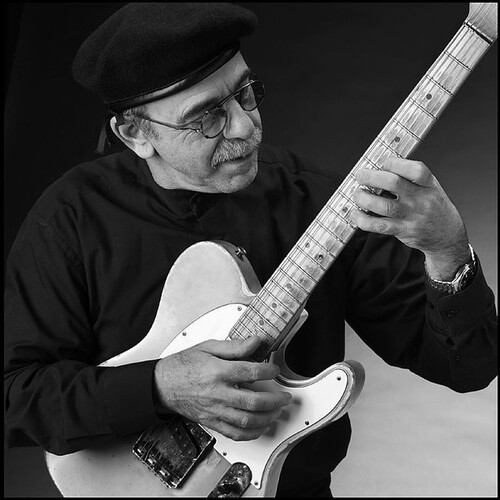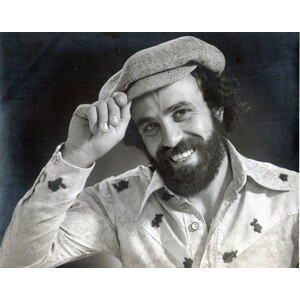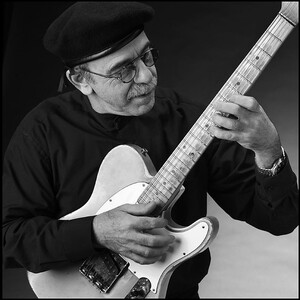Marco, Kenny
Websites:
https://www.facebook.com/events/the-bassment/kenny-marco/294707051020138/
Origin:
Brantford, Ontario - Saskatoon, Saskatchewan, 🇨🇦
Biography:
Brantford-born Kenny Marco is doubtlessly the most prolific guitarist in the history of Canadian rock and roll. His twenty year career has taken him through roles as lead guitarist with the Galaxies, the Beau Keys, E.G. Smith and the Power and Motherlode, resulting in session dates with the likes of Sandy Nelson, Etta James, Jackie DeShannon and Moe Koffman.
The following interview with Marco was conducted by Blitz's Canadian correspondent, John Mars in Brantford.
BLITZ: What was the first music that interested you?
MARCO: My roots are gospel and blues. I used to turn a lot of kids from my generation on to southern stations. I sang in the church choir, but it was nothing like I heard coming out of the stations in Nashville!
I liked the James Cleveland Sin.gars, the Edwin Hawkins Singers and the Five Blind Boys, as well as the blues acts like Bobby Bland and Ray Charles.
BLITZ: When did you get your first guitar?
MARCO: I bought my first guitar at Ken's Radio in Brantford, Ontario. I had a morning paper route. I used to go by their window on my bike, delivering papers . I looked at this guitar hanging in their window, and I grew attracted to it. lt was a hollow-body Exquisite, $59.95 with a pick-up attachment. I also had a part-time job in a drug store when I was in grade seven, so I was about twelve years old. I played that guitar for a while then, and I put it down. Then my brother started playing it better than met I thought I 'd better get my chops together. I picked it up again and started playing with other guys in the neighborhood, just to drive each other's parents nuts.
BLITZ: You went to high school at Pauline Johnson Collegiate in Brantford , Ontario. Did you know the folk-singer, Ray Materick, who also attended school in Brantford?
MARCO: I only know of Ray through his albums.
BLITZ: What were your first bands? Did you play any gigs while you were in high school?
MARCO: The first band was called the Galaxies. We were all students, except for the singer, who was out and working. We all went to Pauline Johnson or North Park Collegiate in Brantford. We played all the regional dances, and also played in Toronto. We used to play in the Jubilee Pavillion in Oshawa, which was owned by the father of John Kay of Steppenwolf. We traveled as far as Windsor and Chatham. We were semi-pro .
BLITZ: Did everyone from your high school bands continue in music?
MARCO: Everyone dropped out of music, with the exception of Wolf Stalling, who plays keyboards . The last I heard, he was playing in clubs with the Platters. We also had a band with our friend, Brian Ayres during school, that we called the Marque-Royales.
BLITZ: What was your first professional band?
MARCO: My first record date was playing with Sandy Nelson on his recording of Peter Gunn.
BLITZ: During the mid 1960s, many of the Ontario rock bands like Mandala, George Olliver And The Child ren, E.G. Smith And The Power and your own group, Motherlode were very much influenced by soul music. What brought that scene to Ontario?
MARCO: Up here, there seemed to be a cult amongst the players. We would often go to Buffalo to buy records to find the kind of material we wanted to do. We all played in the States, and the only way to survive down there was to play that kind of music. We were playing in Boston and New York, where R&B was very popular. We had a good scene going in Toronto at the Blue Note Club. People like Stevie Wonder and the Supremes were coming in after hours to jam with he local bands. When William "Smitty" Smith moved up here during that time from Norfolk, Virginia. He had an influence. We had quite an influx of American players up here then, because of the draft.
BLITZ: What was your favorite Ontario band playing R&B at that time?
MARCO: The Hawks. They did a lot for introducing Canadian players. I played with Ronnie Hawkins, but not when his band was called Ronnie Hawkins And The Hawks. The only other band I can remember besides his was the Beaumarks. That was Ray Hutchinson's band , the singer and the guitar player. That band used a lot of echo!
BLITZ: There was an alleged controversy about your band putting butter on your speakers at the time
MARCO: That was totally a spoof. People would approach us and ask us how we got our sound. We would tell them to slice the speaker with a razor blade or put butter on the speaker!
BLITZ: How did you become associated with Grant Smith?
MARCO: Through Brian Ayres, whom I played with in the Galaxies. I was still playing in the Beau Keys with Roger Pace, the singer , and I got a call from Brian Ayres and Grant Smith, who were negotiating a deal for Grant in New York. The Beau Keys were about to break up. So I finished my gig with them and flew to New York to join Grant and Brian. Originally, Brian had also played with the Beau Keys. We've been friends a long time . We were playing at Trude Heller's in the Village and recording. E .G. Smith And The Power consisted of Wayne Stone, Steve Kennedy, then I joined, then William "Smitty" Smith. And there was Mike Harrison on bass. Wayne played drums. Val Stevens played key boards . Steve Kennedy and Brian Ayres played saxophone. Ralph Miller played trumpet. And of course there was Grant.
BLITZ: At the time , E,G. Smith And The Power were compared frequently to Mitch Ryder And The Detroit Wheels.
MARCO: I have to agree with that. There was no originality happening in that band. That's why Wayne Stone, Steve Kennedy, Smitty and myself left to form Motherlode. We wanted to write, but there was no room to do it. If you listen to the E.G. Smith And The Power album , you 'll see that it's all other people's material. It was a very low budget affair, cut on eight track . We just did the stuff we were doing on stage every night. We cut that album in about six hours. I don 't mind listening to it, but not for too long!
BLITZ: Wasn't Keep On Running the first single produced in Canada to achieve gold status?
lllARCO: I don't really know. We played the eastern seaboard clubs at that time and took the record around to the stations. The border stations played it a lot. It was a hit in Buffalo. We used to play in a cl ub down there called the Inferno, which eventually burned down!
BLITZ: Did you ever do an y television appearances l'f .£h Grant Smith And The Power on shows like Music Hop or let's Go?
MARCO: The group was a regular on the CTV pro gram After Four before I joined. After I joined, we did all the CBC television shows. Those films would be great to see now! The picture on the cover of the Grant Smith album is from one of those shows, and was taken before I joined the band. So Jon Palma is the guitaris\ in the front cover photo and I'm in the back cover shot.
BLITZ: Were there any gigs then that had a n umber of Canadian acts on the same bill?
MARCO: There used to be a place called the Broom And Stone in Scarborough, which was a curling rink. We would work there with Mandala and Shawne Jackson and her old band, the Majesties. We all rehearsed at The Hawk's Nest, which was above Le Coq d'Or, where Ronnie Hawkins played . The Man·dala would rehearse from nine until one, we re hearsed from one until four and the Majestics would rehearse from four until eight. We all worked hard at trying to make the Toronto scene work.
BLITZ: How did you feel when American magazines said that groups like Mandala were playing plastic soul? Do you think the media was being prejudiced against Toronto bands?
MARCO: We didn't feel endangered by it. But about this thing with Mandala; there was a group from the south of the U .S. at the time, who had a hit with Girl Watcher.
BLITZ: The O'Kaysions.
MARCO: Right. We ended up touring with them down there. I couldn't believe it when they turned out to all be white fellows! They were from Georgia, and they were having success on the black radio stations. They told us that they never allowed any publicity pictures with their promotion. The Mandala went the other way , with their blue-eyed soul promotion .
BLITZ: Do you think that groups like John Mayall's Bluesbreakers and Savoy Brown helped to kill that stereotype?
MARCO: I don't know. I didn't listen to them. I guess that they listened to the same records that I did. I used to listen to George Benson when he was still with Brother Jack McDuff. I also listened to Wes Montgomery, who was quite pleasant. But I never really sat down and copied things off of recordings. We had a gig for three weeks at Caesar's Palace in Las Vegas when I was with Grant Smith. We had the late show, following B.B. King. I got to listen to him night after night. I was amazed, because he played the same solos every night. I can't understand it. I used to like Freddie King better. I had a 45 of Freddie King's lonesome Whistle Blues that I wore out.
BLITZ: So you left Grant Smith's band to start Motherlode because you wanted to do original material.
MARCO: Exactly. It was a mutual misunderstanding! We just weren't enthused about playing other people 's material. We left on relatively good terms and went right into rehearsal. Doug Riley and Mort Ross, our personal management had connections with Neil Bogart and Buddah records in New York. Six months after Motherlode was even thought of, we had When I Die out.
BLITZ: Was it a surprise to you that it was such a hit?
MARCO: Not really. I thought that the whole concept was magic. I 'd never felt that kind of camaraderie between the players before. Everything was working. We lived together for four weeks and came up with that album. We rehearsed in London, Ontario and gigged there on Friday and Saturday nights. We came back to Toronto and did a demo session with Diane Brooks as a backing vocalist. But we decided that we didn't need her. We knew we had the material.
BLITZ: Can you explain why the When I Die album didn't do as well as the single?
MARCO: I can't recall what the record sales were. The band was always much better received in the U .S. The album did quite well in the U.S., but I guess it didn't do all that well in Canada.
We didn't play in Canada much after that. In fact, it wasn't until the record had been a hit in the States for two months that most of the Canadian stations picked up on it.
BLITZ: Did you headline in the U.S. or open for other groups?
MARCO: Usually we headlined. We played the big pop festivals where nobody really headlined , throughout 1969-1970. We did the Rock and Roll Revival in Toronto with Chuck Berry. John Lennon showed up for that. It was a nice feeling to jam with all the people there in the back stage room. Touring on our own, we had a lot of success on the west coast, mostly in California. We played all the states, with the exception of Alaska and Hawaii. I remember working the Buddah records convention in New York with other Buddah artists. We came off looking good. That was important, because all of the record company were there. This was soon after the album was released.
BLITZ: Can you explain that dramatic interplay that Motherlode had between the saxophone and the guitar? It sounds as though the band was trying to emulate an entire horn section with just those two instruments.
MARCO: That's exactly what we were trying to do at times. Steve Kennedy still plays with me occasionally . What we try to do is give the band a little more depth by playing lines together rather than him honking some notes and me just chording along.
BLITZ: Motherlode did a version of the Allen Tous· saint composition, Get Out Of My life, Woman, which was also covered by the Paul Butterfield Blues Band on their East-West album.
MARCO: We played with Butterfield once. We got the arrangement for that song from the Lee Dorsey version of it.
BLITZ: What were the circumstances behind the demise of Motherlode?
MARCO: A little too much money was going to management and not enough was going back into the band. We knew we were getting burned.
BLITZ: Did you have to break up to get out of your contract?
MARCO: The contract with Neil Bogart and Buddah records was signed by both management and the band, so we couldn 't go to the label separately. The contract called for two albums. We did the second album under a lot of stress, because we knew we were going to break up. Still, the second album came out nice . But we folded specifically because of management, and management still owns the name Motherlode. After Motherlode folded, I played and recorded with the Toronto group, Dr. Music for about a year and a half. I also started playing on commercials. Then I moved to Los Angeles and joined David Clayton-Thomas in 1972. I lived on the beaches in Pacific, Palisades until 1975. I'm still very much in touch with the people out there. I married a girl from out there. I played the big Las Vegas gigs with David, toured and recorded with him. It proved to be very lucrative. Smitty and Chuck Rainey were in the band, as was Kenneth Rice, the Motown session drummer. It was a hot band. Later, when David re-joined Blood, Sweat And Tears, I went and toured with them, but I never stuck around long enough to record with them .
While I was in Los Angeles, I did record dates with other artists, like Etta James and Jackie De Shannon. I worked with Jackie DeShannon live at the Troubador and played on her Atlantic albums . which were produced by Tom Oowd. She had some nice tunes and she was a good person.
BLITZ: What were the notable points of your career since that time?
MARCO: I did some concerts with Blood, Sweat And Tears as recently as two years ago. I did a solo single with Smitty, Wayne Stone and Steve Kennedy back ing me, called Happy People. I've been continuing with writing . I have a lot of material sitting on tapes, with no lyrics as of yet. I have an interest in recording a new band. It's a matter of finding the right players and getting that camaraderie going with them.
-John Mars, Blitz Magazine, July-August, 1982



